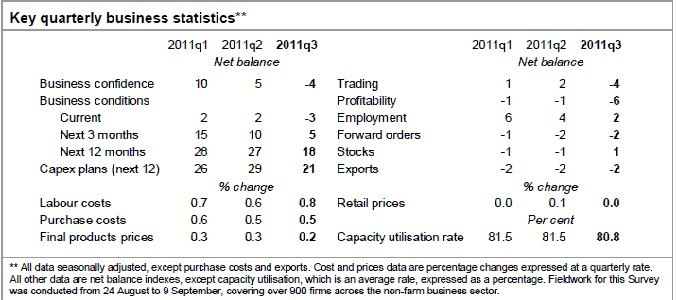
The September quarter NAB Business Survey is out and as you can see above. It shows an economy with slumping confidence and conditions, but stable pricing. NAB also makes a point of describing an economy suffering from an unprecedented division between weakness and strength:
Business conditions slump and confidence falters mid-quarter, but monthly profile points to subsequent improving trend. Hours worked strengthens and capex remains strong.
Business conditions stumbled in the September quarter, reflecting an economy that it is still struggling to find traction, while activity is also seemingly being impacted by global influences. In the quarter, falls were recorded in trading conditions, profitability and employment. Forward orders remained weak and stocks were negative, implying an expectation of softer near-term domestic demand.
Conditions deteriorated across industries and states in the quarter. However, monthly data suggest that conditions had regained lost ground by the end of the quarter.
The gap between weak & strong industries reached its largest in history. This largely reflected a significant weakening in the poor performers – similar to the 2000 slowdown.
Business confidence fell heavily in the quarter, no doubt reflecting the volatility in equity and financial markets, heightened fears about debt contagion in Europe and the deterioration in conditions. Confidence fell across all industries and states. Consistent with conditions, monthly data showed a rebound in confidence at the end of the quarter, although it remained negative.
In new information contained in this survey, business capital spending intentions over the next 12 months fell a little in the September quarter, but remain at levels consistent with strong business investment (of around 10% per annum). Consistent with near term weaker activity and labour market data, employment expectations for the next 12 months also eased back. That said average hours worked increased, implying that employers may be delaying hiring until they feel more confident about future economic conditions – but in the interim are working their existing labour force harder. Lack of demand is expected to remain the most constraining factor on profitability over the year ahead, while interest rates, wage costs, capital capacity and suitable labour remained fairly unimportant.
Product price inflation weakened to a more subdued annualised rate of 0.9%. Retail prices were relatively flat, which together with rising input costs implies weaker retail profit margins.
The only other point I would add is that the quarterly survey contradicts the recent monthly survey’s jump in the employment index, adding in some very small dimension to the chances of a rate cut.

